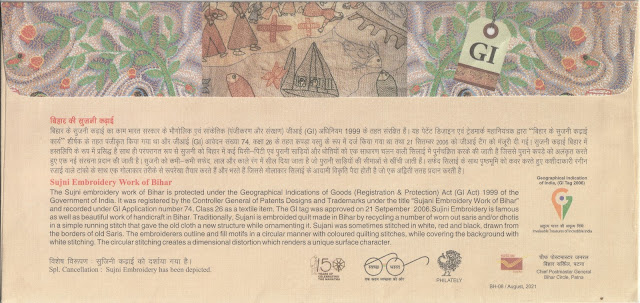Sujini Embroidery Work of Bihar is a traditional form of hand embroidery exclusively made by women in villages of Bhusra in the Gaighat block of Muzaffarpur District. It is usually a quilt or bed spread, which was earlier made of old clothes, but is now generally made of easily available fabric with embroidery done with the most simple stitches with motifs narrating stories.
The earliest known traditional practice of making the embroidered Sujini quilt is traced to the 18th century. It possibly began as a ritualistic practice in tribute to Chitiriya Ma, the lady of tatters.
Traditionally, the Sujini technique was used to put together a quilt from old sarees and dhotis for new born babies. It was then made with pieces of cloth in different colours derived from used saris and dhotis by sewing them together, adopting a simple running stitch. The word Sujini is a compound word of ‘su’ meaning "easy and facilitating" and ‘jani’ meaning "birth".
The uniqueness of Sujini embroidery primarily lies in its story-telling theme. Stories are mainly based on contemporary problems of peace and harmony and issues related to the rural women’s world. The stories depict themes ranging from village life and the Hindu epics to concerns about election violence, the education of girls, and lessons in health care.
The outline of the design is traced or drawn directly on to the cloth. A fine running stitch all over the sheet in the same colour as the base cloth prepares the background. Chain stitch (usually black or red) is used to outline the motifs, and the details are then filled in with tiny running stitches in coloured threads.
Sujini embroidery designs begin either from the central or the outer layers depending on what the dominant features will be. The rest of the Sujini is filled in with figures, objects, symbolic scenes, shapes and combinations left totally to the imagination of the craft woman.
The stitches used are of the simplest kind. The running stitch is the main stitch. The empty spaces are filled with the running stitch, length and spacing being regulated. The running stitch moves around the patterns to create a rippling and whirling effect, molding and making the motifs stand out against the background of the cloth.
Sujini embroidery resembles Kantha stitch of West Bengal but varies from one another in terms of hues, motifs and motifs. The main difference is that in Kantha weaving craftsmen do not follow a particular method of stitching as they follow any direction of their choice while Sujini embroidery deals with stitching carried out in straight lines.
Most of the Sujini furnishing items today are produced on cream markeen fabric. Occasionally brown and black casement fabric is used. Coloured mull or handloom is used for saris, kurtas, and dupattas, and sometimes tussar silk is used in making stoles and jackets. Sujini embroidered work includes bedspreads, wall hangings, and cushion and bolster covers as well as clothing items like saris, dupattas, and kurtas.
GI Tag Registration Date : 23 November 2007
GI Tag Number : 74
Certificate Number : 45
Geographical Area : Bihar
Special Cover Release Date : 25 August 2021
Cancellation : Muzaffarpur 842 002
Type : GI Tag Cover
Cover Identification Number : BH-08/August,2021
Enlarged View of Illustration
India post has also issued a postage stamp on Sujini Embroidery. Details of the same are furnished below
Sheetlet - Embroideries of India - Sujani
Issued on 19 December 2019






Nice coverage.
ReplyDeleteThank you sir
ReplyDelete